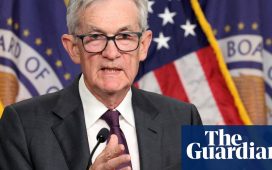Stay informed with free updates
Simply sign up to the US interest rates myFT Digest — delivered directly to your inbox.
Federal Reserve chair Jay Powell signalled that the US central bank would consider reverting to its more usual quarter-point cut in November if economic data remained robust, after delivering a larger-than-usual half-point reduction earlier this month.
Striking a positive note about the health of the world’s largest economy, Powell said on Monday that the Federal Open Market Committee was “not a committee that feels like it’s in a hurry to cut rates quickly”.
Rather, the goal of the FOMC was to move monetary policy “over time towards a more neutral stance” — a level that neither stimulates nor restrains economic activity.
The November decision, due just two days after the US presidential election, would be based on the “totality” of the data, Powell said — but gave little sense that the Fed needed to deliver another large cut given the strength of the economy.
“From a base case standpoint, we’re looking at it as a process that will play out over some time, not something that we need to go fast on,” he said.
The Fed chair was speaking publicly for the first time since the central bank earlier this month began its first easing cycle in more than four years with a larger-than-usual half-point cut, leaving rates at 4.75-5 per cent.
“That decision reflects our growing confidence that, with an appropriate recalibration of our policy stance, strength in the labour market can be maintained in an environment of moderate economic growth and inflation moving sustainably down to our objective,” Powell said at an event at the National Association for Business Economics.
Now that inflation has retreated and the economic backdrop has “set the table for further disinflation”, Powell said the Fed’s focus would be on safeguarding the labour market, which is still “solid” despite demand cooling meaningfully.
“Our goal all along has been to restore price stability without the kind of painful rise in unemployment that has frequently accompanied efforts to bring down high inflation,” Powell said on Monday.
In a moderated discussion after his speech, Powell parsed the latest “dot plot” of Fed officials’ individual projections, which showed that most policymakers expected the benchmark rate to fall by another half a percentage point over the course of the two remaining meetings of the year. Almost half of the 19 officials thought the Fed should do less than that.
Powell said the “baseline” was two more quarter-point cuts rather than another half-point move.
Policymakers also expected the federal funds rate to fall another percentage point in 2025, ending the year between 3.25 per cent and 3.5 per cent. By the end of 2026, it was estimated to fall just below 3 per cent.
In an interview with the Financial Times on Friday, Alberto Musalem of the St Louis Fed endorsed the central bank reverting to cutting rates “gradually” given concerns that the economy could react “very vigorously” to looser financial conditions. A half-point reduction would however remain on the table if the labour market weakened more than expected — something his colleague Raphael Bostic of the Atlanta Fed backed on Monday.








